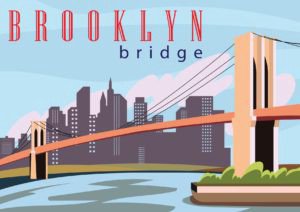
George Parker was a Con Man Extraordinaire in New York in the 1920s with the Gift of the Gab.
He sold property he did not own to gullible immigrants, just arrived in the Big Smoke.
He repeatedly sold the rights to levy tolls on the Brooklyn Bridge. It is reported that the police removed several of his victims from the bridge as they tried to erect toll booths. In addition to his Brooklyn Bridge scam, other public landmarks he sold included the original Madison Square Garden, the Metropolitan Museum of Art and the Statue of Liberty. He produced convincing forged documents as evidence that he was the legal owner of whatever property he was selling.
George Parker is responsible for the popular saying –“and if you believe that, I have a bridge to sell you”.
We believe in a straight deal. In other words, what you see is what you get. Perhaps that's why – although we've been woo'd by many MLM entrepreneurs over our 20 years, we've never taken the bait of the promised huge profits for us as vendors.
The George Parker story reminds us that when you join an MLM there are at least two things at play.
Firstly, the product which you buy – almost always over market price – because you've been convinced of its worth by a friend or that friend's friend. (Both signed on to the same MLM).
Second, the promise. You bought a product and a promise of the same thing they always held out to me – easy money.
But.. you also get something else in your shopping bag – something you may not have asked for. Before I tell you what it is, let me ask a couple of questions.
If you only had a 1 in 20 chance of surviving a road trip, would you take it?
If your supermarket told you the food they supply you has a one in twenty chance of being free of germs, would you buy it?
And finally, if your bank told you they had a 1 in 20 chance of remaining solvent, would you bank with them?
So.. when you agree to sign on as an MLM independent distributor* you have on average – a 1 in 20 chance of ever getting your initial investment back.
If you aren't as good in selling to strangers as some of the high flyer reps you've been shown, it's pretty fair to say that you are not the one in twenty.
Finally, a small vignette. Imagine coming home on payday. You greet your partner and as is your habit, you have your weekly financial summit. She/he shows you what they've added to your joint bank account this week, and then you show them what you bought.
How much did you say this thing cost?
There's on last point. It's been my observation over the last 30 years that most MLM products are NOT the latest and the best. They are very often outmoded with new technology outperforming them. But because you got caught in the MLM trap, you probably didn't research it. Or if you did, you also got caught in the scarcity trap.
Here's how that goes:
Look, I'm your friend, and I have to tell you that this is a new market. Get in now and you'll sell the product easily because no-one knows about it. And because you sell lots you'll have all these people working under you. And they'll be making you money every day for you doing nothing. So you'd better sign on now.. and by the way, if you buy more stuff now.. well, that's a better deal.
* 1. An independent distributor is someone who has to buy all his/her brochures and advertising, pay all his own Facebook advertising, and spend many cold nights in church halls selling. A good independent distributor still works very, very hard se most MLM schemes introduce clauses that enforce a quota of new business for you to keep your benefits. No work, no pay. Remember: The MLM company has all the power. You have none.
* 2. The Direct Marketing Association quotes that one in twenty people who join MLM schemes ever recoup their initial investment.


